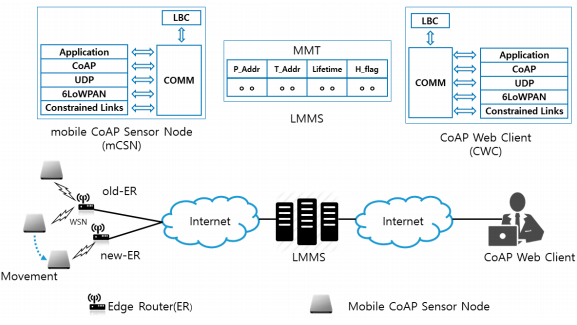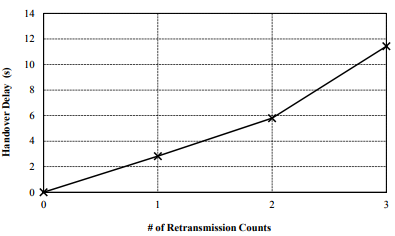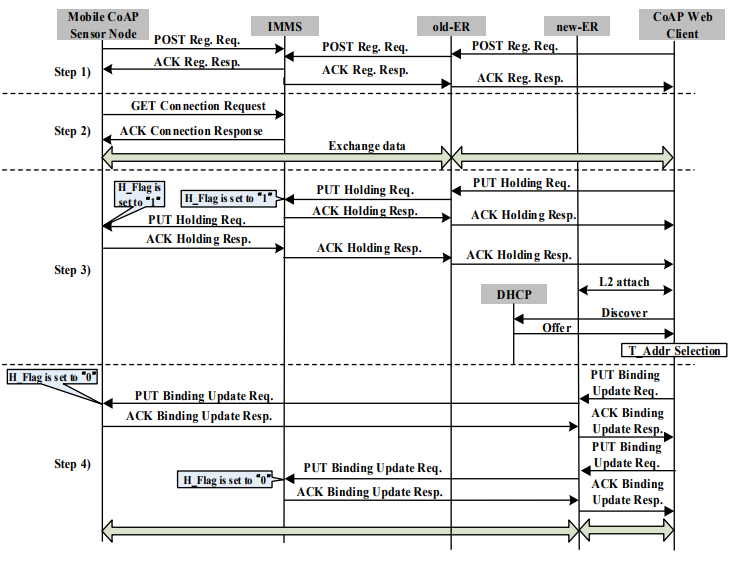ABSTRACT
Under unreliable constrained wireless networks for Internet of Things (IoT) environments, the loss of the signaling message may frequently occur. Mobile Internet Protocol version 6 (MIPv6) and its variants do not consider this situation. Consequently, as a constrained device moves around different wireless networks, its Internet Protocol (IP) connectivity may be frequently disrupted and power can be drained rapidly. This can result in the loss of important sensing data or a large delay for time-critical IoT services such as healthcare monitoring and disaster management.
This paper presents a reliable mobility management mechanism in Internet of Things environments with lossy low-power constrained device and network characteristics. The idea is to use the Internet Engineering Task Force (IETF) Constrained Application Protocol (CoAP) retransmission mechanism to achieve both reliability and simplicity for reliable IoT mobility management. Detailed architecture, algorithms, and message extensions for reliable mobility management are presented. Finally, performance is evaluated using both mathematical analysis and simulation.
ARCHITECTURE AND PROCEDURE OF RELIABLE MOBILITY MANAGEMENT

Figure 1. Reliable mobility management architecture using Constrained Application Protocol (CoAP)-based Mobility Management Protocol CoMP
In Figure 1, we present the reliable mobility management architecture using CoAP-based Mobility Management Protocol (CoMP). The components of the architecture consist of a mobile constrained sensor node (mCSN), IoT Mobility Management Server (IMMS), and CoAP Web Client (CWC). The IMMS maintains the location information in the Mobility Management Table (MMT), which is necessary to perform mobility management, thereby managing the changed IP address of an mCSN. The CWC is a Web browser equipped with the CoAP protocol.
Figure 2 shows the signaling flow diagram for CoMP. All control messages use a confirmable message as Figure 2 indicates. The signaling flow diagram includes registration, connection, holding, and binding. We assume that mCSN obtains the P_Addr, T_Addr, and Lifetime from old-ER.
RELIABLE MESSAGE TRANSMISSION ALGORITHM AND ANALYSIS OF HANDOVER DELAY OF COMP
In this section, we describe the algorithm of signaling message retransmission for a reliable mobility management algorithm of CoAP-based Mobility Management Protocol (CoMP), and analyze the performance of the handover latency. The CoMP extends the CON message of the CoAP protocol to reliably transmit the signaling message under an unreliable IoT network environment. In particular, the retransmission is instrumented by using a Message ID and CON message of the CoAP protocol, using CoAP PUT message.
PERFORMANCE EVALUATION

Figure 3. Average number of retransmission counts for f fragmented CoAP messages
The quality of service requirements for the handover delay depends on the message type of the IoT application, such as discrete or continuous message data. Figure 3 displays the average number of retransmissions. As the probability of packet error rate is lower than 30%, the CoAP message is retransmitted only once.

Figure 5. Total handover delay with considering CoAP retransmission mechanism by impact of Tr
Figure 5 exhibits the total handover delay with the CoAP retransmission mechanism by impact of Tr. As the packet loss rate is approximately 50%, the handover latency increases to 4.3~4.5s. In this way, CoMP supports reliability in the handover operation. Conversely, the related standard mobility protocols such as MIPv6 and HMIPv6 do not support reliability. As the failure of signaling message occurs, these mobility protocols do not support an automatic retransmission mechanism.

Figure 6. Handover delay by increasing retransmission counts
Figure 6 shows the handover delay by retransmission counts. Although the handover delay due to the retransmission can be increased, the CoMP can guarantee the reliability of handover message by using CoAP retransmission mechanism. On the contrary, the related standard mobility protocols such as MIPv6 do not support the retransmission mechanism.
CONCLUSIONS
In this paper, we have presented a mechanism for reliable IoT mobility management using CoAP. In particular, the detailed algorithm and performance analysis are presented for achieving the reliability of mobility management in Internet of Things environments. Most standard mobility management protocols at the network layer such as MIPv6 and its variants do not consider packet retransmissions during handovers because the network layer does not support packet retransmission. In this paper, we have extended the CON message of the CoAP protocol for reliable transmission of the signaling message under an unreliable IoT network environment.
A detailed mathematical analysis of the retransmission model for supporting the reliable mobility management has been presented. Finally, performance is evaluated by both mathematical analysis and simulation. The performance evaluation confirmed that the proposed mechanism can effectively support reliable mobility management. Further study may be required to provide the security aspect of the proposed mechanism.
Source: Kyungpook National University
Authors: Seung-Man Chun | Jong-Tae Park
>> 200+ IoT Led Projects for Engineering Students
